
Aoling Festival at Nagaland – The Grand Festival of Konyak Nagas
While India is known for its festivals and has gained the moniker of “land of festivals” to the world, it is Nagaland which is known as the “land of festivals” within India. I have been planning a trip to Nagaland for a long time to get a glimpse of the cultural aspects of the state. Attending the Hornbill Festival is a great way of doing so. After all, the festival offers a vibrant and exuberant display of the culture and traditional rituals of all the tribes of Nagaland. As much as we loved the Hornbill Festival, we were also intrigued by the Konyak tribe. They were the last headhunters of Nagaland, and we wanted to meet them.
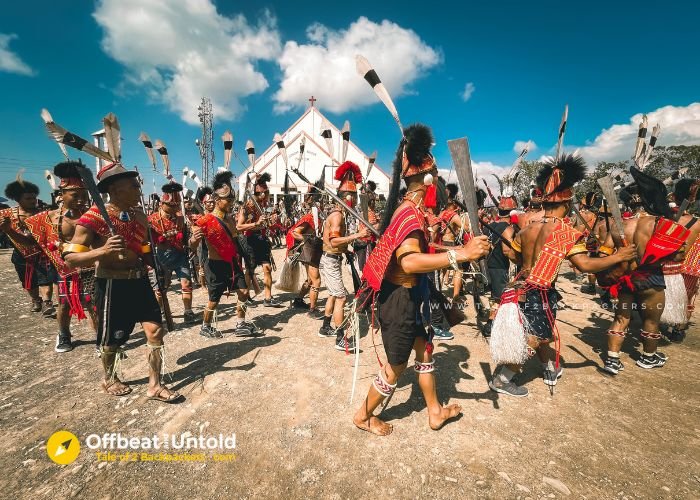
And it is our love for experiencing local and folk festivals of India that landed us at Mon district on the 3rd day of April. We were on our way to attend the Aoleang Festival and get an insight into the life of the famed Konyak tribe of Nagaland while meeting the last of the headhunters of Nagaland.
Mon – the land of the Konyaks
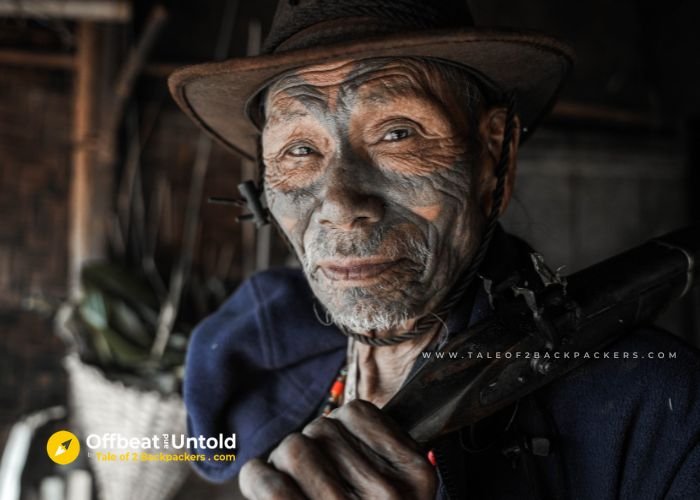
Nagaland, located in the northeastern part of India is one of the smallest states of India – beautiful and wild. It is a land of folktales and fables passed down from generations. The Konyak tribe is one of the most prominent tribes of Nagaland known for their fierce headhunting practices. The Konyaks reside in Mon district of Nagaland which is bordered by Myanmar on the east and Assam on the west.
The Mon district is mostly a hilly region extending from the foothills to the slopes of the Naga Hills and the Patkai ranges. Mon Town is the headquarters of the district as well as the largest town of the district.
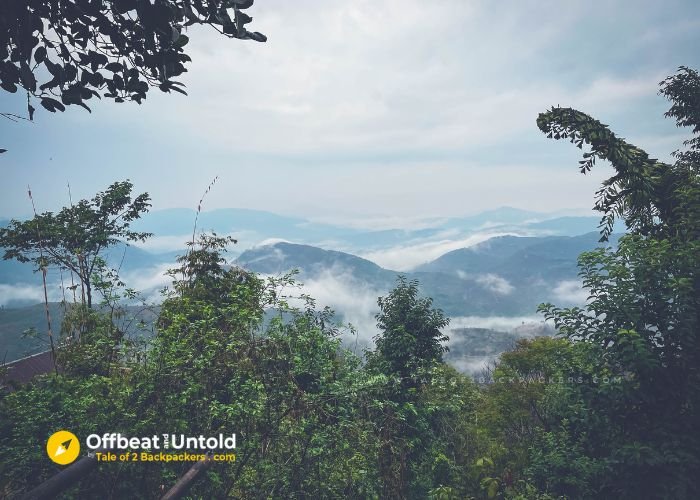
As mentioned earlier, Mon district is the home of the fearsome Konyak tribe who are infamously known for beheading the heads of their enemies and bringing back their heads as a trophy to their villages. If you want to know more about them, please read our article on the Konyak tribe, the fierce headhunters of Nagaland.
Meeting the Konyaks and Celebrating Aoleang Festival with them
Usually when it comes to festivals, we always try to spend most of the time of our trip attending the celebration. Traditional festivals and celebrations are one of the best ways to understand a culture and the people. It gives an interesting insight into the culture of the people and place in a unique way that you might not get if you just visit the place on a trip.
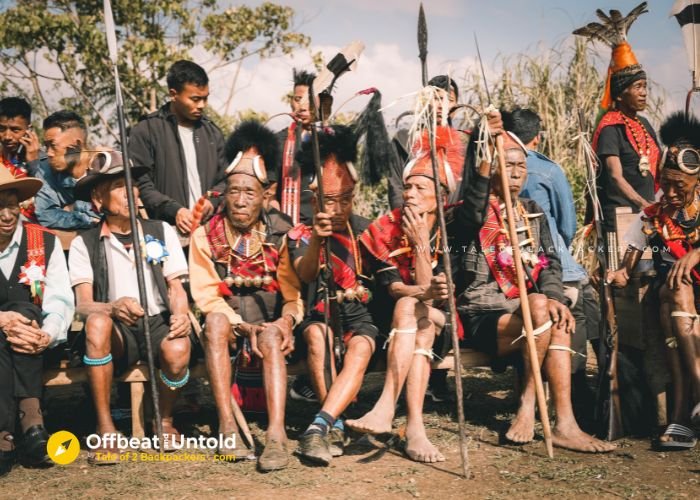
We had only a few days leave this time and so utilized most of the days enjoying the Aoling Festival with the Konyaks. We planned this trip almost at the last moment and as a result we could not find any stay at Mon town. After all, it was festival time and almost all the hotels we called up were booked. We might have gotten a place to stay once we reached there. But a friend suggested a homestay in one of the villages near Mon town.
With trepidation I called up the owner and he confirmed that he has rooms for us. I gladly asked him to reserve the rooms for us.
Reaching Mon
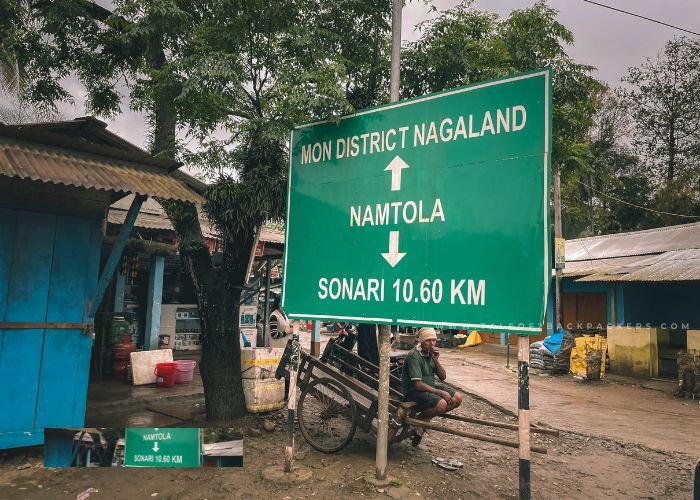
However, once we were in Mon town, we were in for a mild shock. We could not find any directions to Sheanghah Chingyu (that is the village we were going to) on Google Maps. It seemed that in our last few trips, we were traveling to places whose routes are not on our reliable Google Maps!
Nevertheless, we called up our host and he gave us directions towards his village. We drove for almost an hour from Mon town on the Mon-Longwa Road till we came to a signboard saying Sheanghah Chingyu. Taking that road, we off-roaded for another 45 minutes till we reached the village. And all this time, I kept on second guessing my choice of stay. But as much as I doubted my decision, it turned out to be one of the best ones I had taken on the trip.
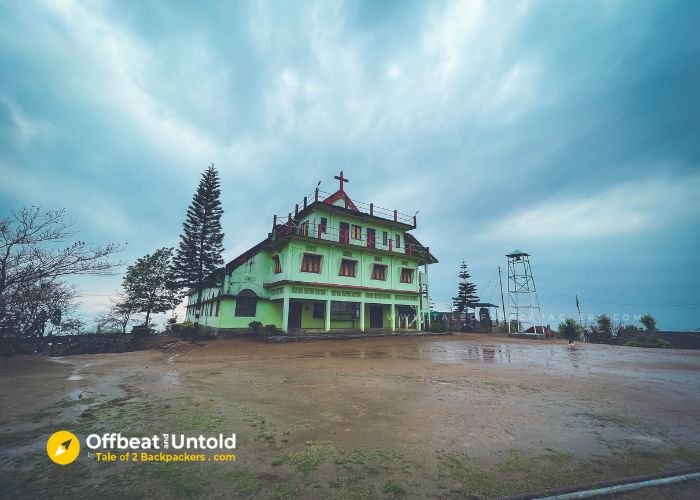
Sheanghah Chingyu was one of the warmest Konyak villages we visited. The people were friendly and we enjoyed our stay in the village. We also got a proper insight and knowledge about the Konyak tribe and the headhunters here after talking to the local people. We visited their traditional log houses, met with the local people, listened to stories of the past and present and enjoyed some great Naga cuisine. And finally, we also celebrated the Aoling Festival with them.
What is the Aoling Festival?
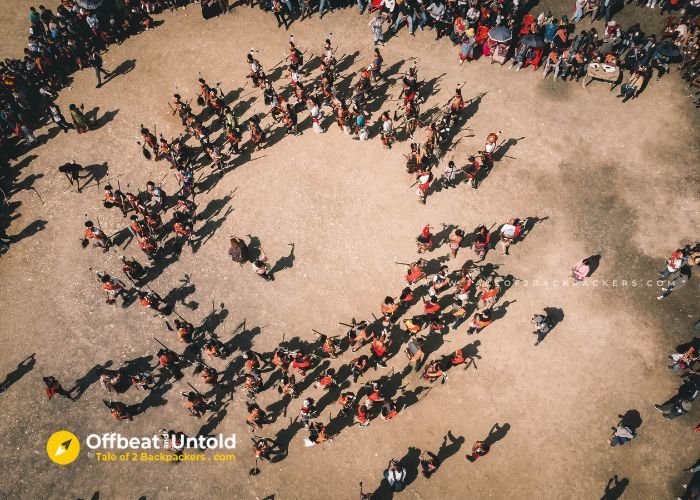
While the Konyak tribe have rituals and feasts all around the year, Aoling Festival is one of their major festivals. A spring festival, it marks the beginning of new year and the start of the sowing season. Also known as Aoleang Monyu, it is celebrated between April 1 to 6 every year after the completion of sowing seeds in their fields. This is done in order to seek blessings from the supreme god, Yongwan. Several rituals take place and sacrifices of cattle are made to appease the supreme power. Family, friends and neighbors are invited over to lavish feasts.
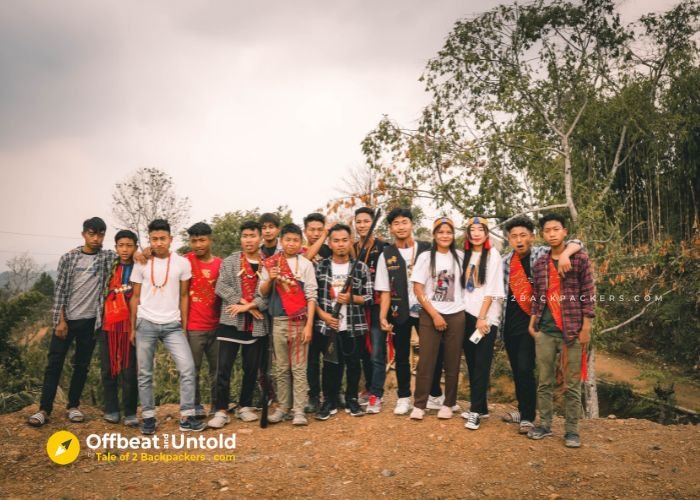
The Konyaks dress up in their traditional gorgeous attires. Both men and women adorn themselves with colorful embroidered dresses and beaded jewelry. It is a time of fun and merriment for them. They indulge in songs and traditional dances and beat log drums. The men in their traditional attire including headdresses decorated with hornbill feathers and boar tusks, and brass skull necklaces perform war dances. It is a way to remember their headhunting days.
Women sing folk songs that speak about the festival and other mundane things of life.
Aoling Festival is also a time when the families of recently deceased say their final goodbyes and end the period of mourning.
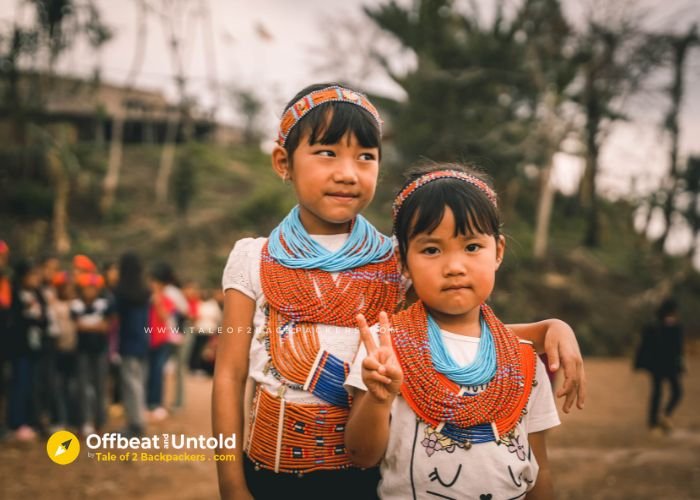


Significance of Aoling Festival or Aoleang Monyu
Each day of the Aoling Festival has its own significance. The first two days are known as Hoi Lai Yah Nyih and Yin Mok Pho Nyih. These two days are for preparation for the festival. Food and rice beer are prepared during this time. The Konyaks get ready traditional clothes and gather the animals that are to be slaughtered.
There is also an interesting ritual on these days. The head of the family goes to their field and sacrifices a chicken and sprinkles its blood on the altar while praying to the supreme power for a good crop season. He also predicts the future of his family by looking at the intestine of the chicken.
The third day is known as Yin MokShek Nyih. On this day, the animals that were gathered are slaughtered.
The most important day is the fourth day known as Lingnyu Nyih. On this day, men and women dress in their traditional attires and ornaments. There are day-long songs and dance performances and merrymaking. And not to forget, the best feast is made on this day.
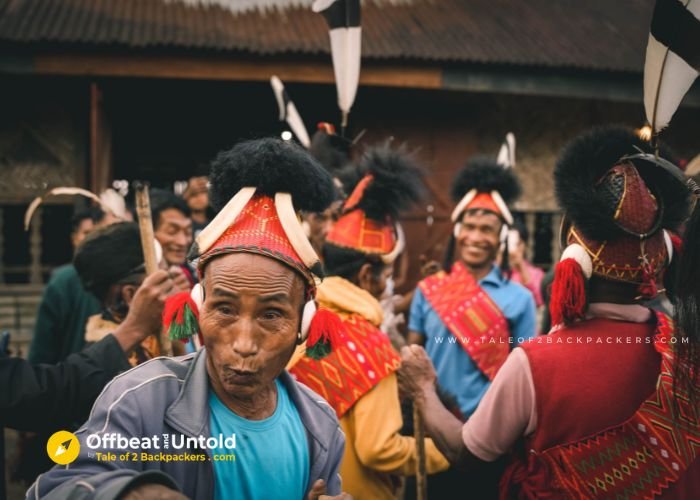
The last two days are known as Lingha Nyih and Lingshan Nyih. In these two days, families spend time with each other and clean their houses after the festivities.
Though each day has its own significance, sometimes, each village might celebrate the main day of festivities on different days. At Sheanghah Chingyu, the main ceremonies of song and dance were held on the fourth day and in Longwa it was held on the sixth day. Thus it gave us the opportunity to observe the Aoling Festival in both the villages.
Our Experience at the Aoling Festival
Mon is quite a remote district in Nagaland. One of the easiest ways to reach Mon is to arrive at Dibrugarh either by flight or train and then drive to Mon. You can also reach there by public transport, about which I will share later.
We arrived at Dibrugarh on a cloudy day and started our journey towards Mon. After a long and bumpy ride among tea gardens and quaint villages, we reached Mon town. Another hour of off-roading brought us to Sheanghah Chingyu village.
Sheanghah Chingyu
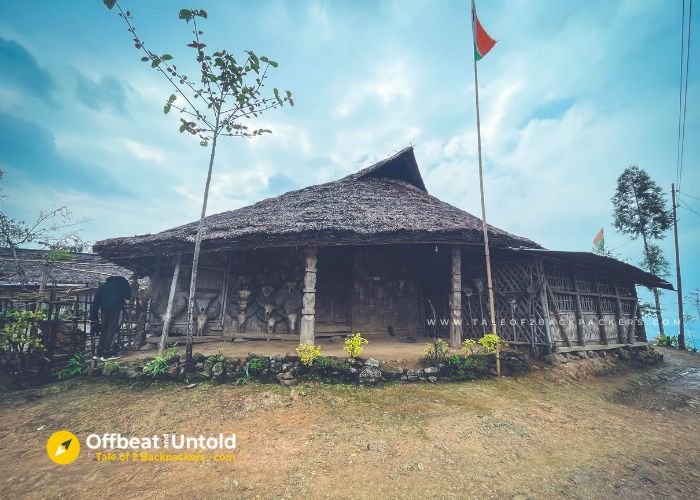
Sheanghah Chingyu is one of the largest villages in Mon district and is one of the most powerful ones amongst the Konyak tribe. Their Ahng (chief), also revered as the king of the village is one of the influential kings of the Konyak region.
We reached Sheanghah Chingyu amidst heavy rains. The homestay where we stayed belonged to the deputy Ahng, or the deputy chief of the village. Incidentally, the Ahng has a certain number of deputies and our host was one of them. He was quite an affable person, always smiling. But we could also see the steel in his eyes, if the situation demanded.
We stayed at the quaint and beautiful bamboo homestay and enjoyed the hospitality. We listened to stories of the past, headhunters and tattooing from the locals. In the evening, we were invited for a feast at a neighbor’s place.
Meeting the Ahng (King) of Sheanghah Chingyu Village
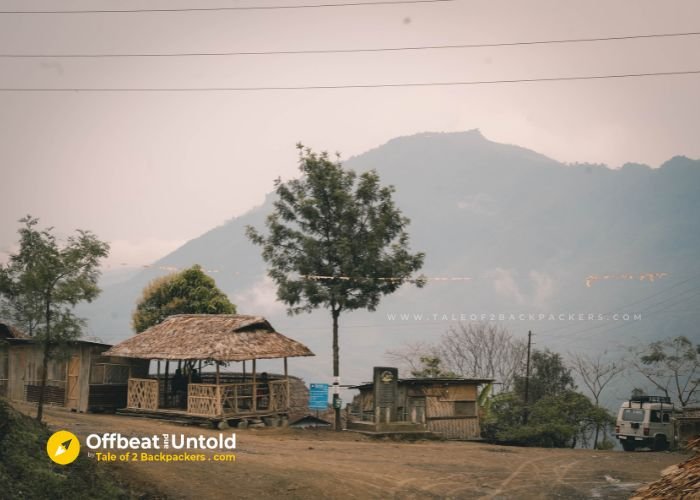
The next day started with heavy rains. Everyone was worried about the weather. After all, who likes weather to play a dampener during festivals! The rain stopped at noon. After that we went out to roam around the village. First, we went to meet the Ahng or chief of Sheanghah Chingyu. It is customary to give the king a gift when you meet him. We bought some eatables from a nearby shop and presented them to the King and Queen when we met. The Ahng definitely looked like someone who yielded quite a power.
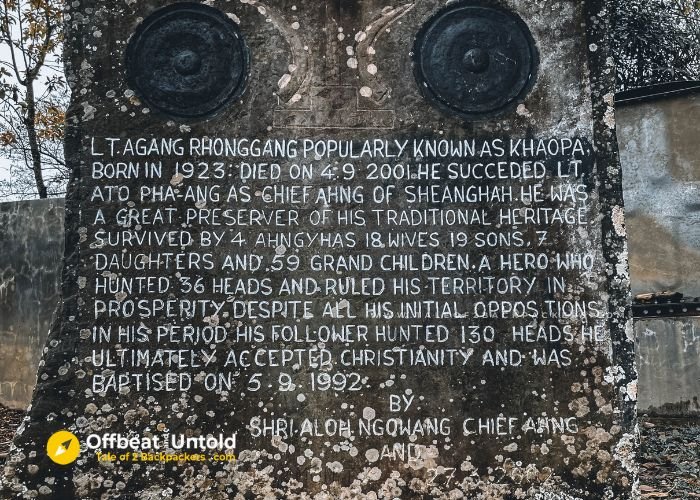
After our meeting with the Ahng, we went on exploring the village. We met a headhunter, who told us stories of the past, albeit with an interpreter. We also met some villagers, went to the gun factory of the village. Oh! Did I tell you that all the Konyak houses possess locally made guns? And these guns are made and assembled in the village itself.
The day passed on lazily and soon it was dark. The next day was the main event of the Aoling festival and we all prayed to the weather gods so that there would be no rains!
Aoling Festival celebration at Sheanghah Chingyu
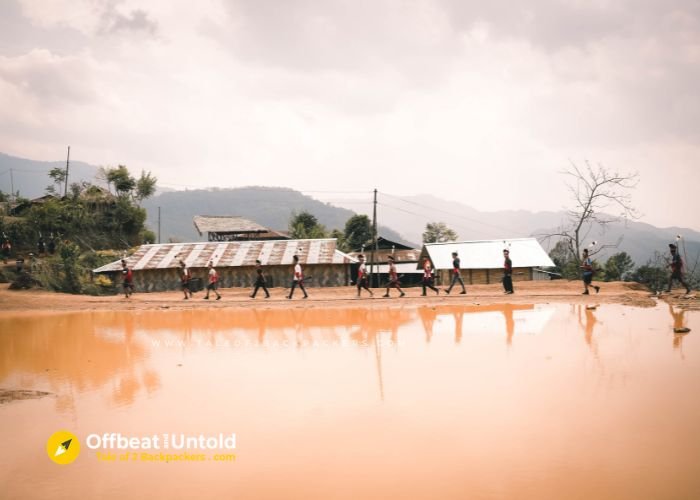
It rained heavily at night and in the early morning. I amost lost any hope of a clear day. However, after 9 am, the sun came up and the sky was cleared off any clouds. We were happy, but the villagers seemed ecstatic.
Some time later we went to the village field where the Aoling Festival celebrations would take place. The field was decorated minimally, as it had been raining the previous days. Gradually, people in their best attires started gathering around the field. We roamed clicking pictures and looking around. Finally, at around 11 am, the celebrations started.
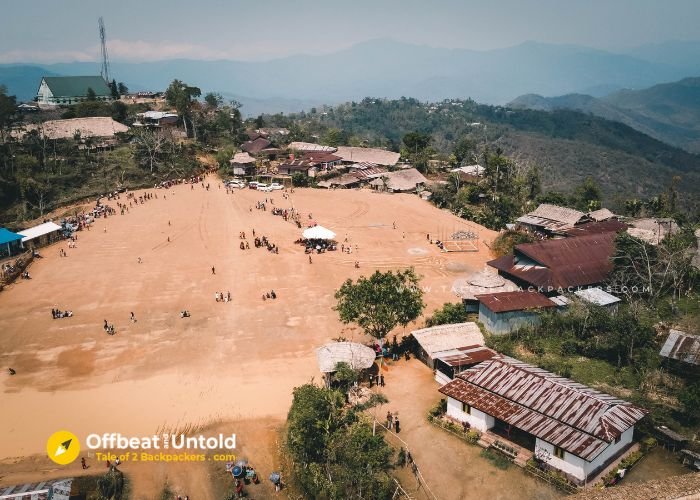
Folk songs were sung. There was a meat eating competition for the men and another one for the women of the village. Then a group of women came in and sang folk songs.
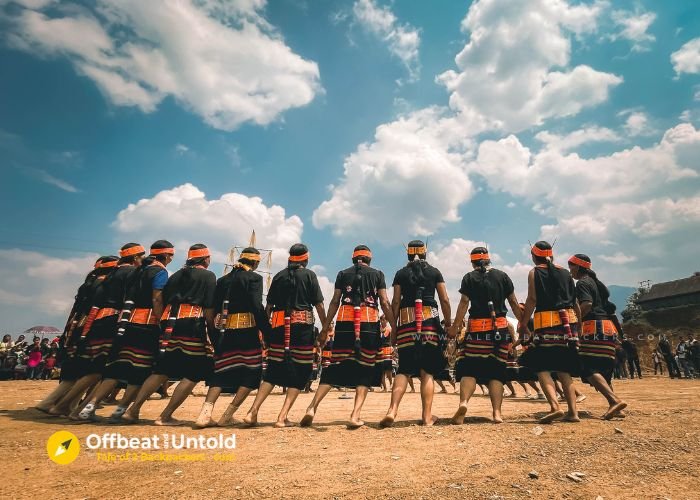
Finally, the men in their traditional attires came in to perform the warrior dance. They enacted scenes from what used to happen during the headhunting expeditions. It was such a vivid and flamboyant affair.
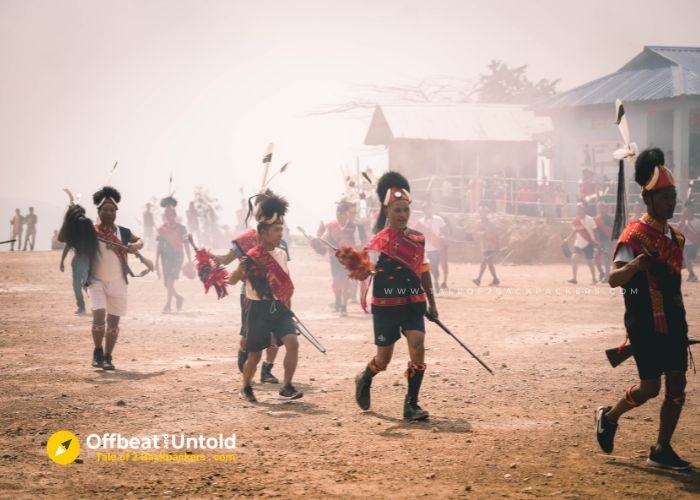
We simply did not know how time passed. Soon it was 2 pm and the celebrations were almost over. People started going back to their homes laughing and making merry. But all was not over. The celebration ended with a gun firing competition.
The Aoling Festival celebration at Sheanghah Chingyu was a beautiful and lively affair. And it was so raw and unfiltered. I was glad that we had decided to come to this village to witness the Aoling Festival celebration.
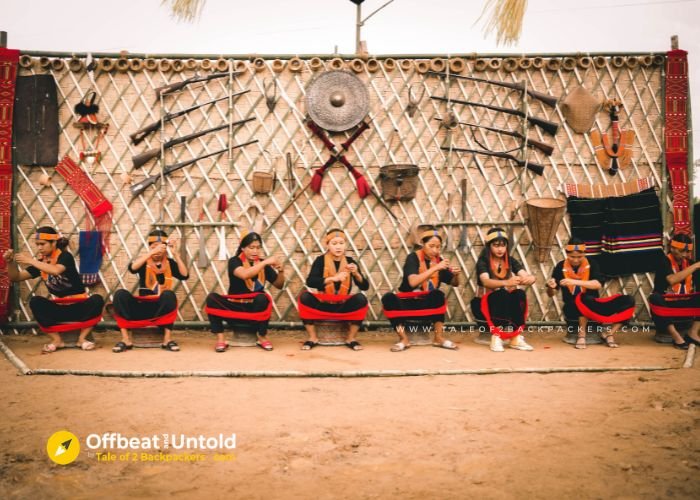
After attending and celebrating the Aoling Festival at Sheanghah Chingyu, it was time for us to head to our next destination, Longwa. The main celebrations of the Aoling Festival was to be held there the next day and so we headed towards this border village of Nagaland.
Longwa
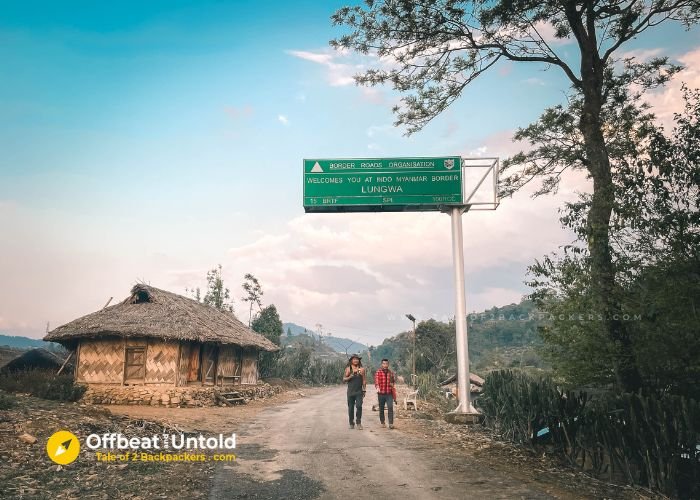
Longwa is an interesting place located by the Indo-Myanmar border. In fact, the international border lies through the middle of the house of the Ahng of Longwa. The Ahng of Longwa is a powerful person. He rules over 30 Konyak villages in Myanmar and 11 Konyak villages in India. And as such the residents of Longwa has dual citizenship. They can easily pass the border to meet their relatives. This is also one of the most peaceful borders between two countries. It is often jokingly said that the Ahng sleeps in India and has his breakfast in Myanmar!
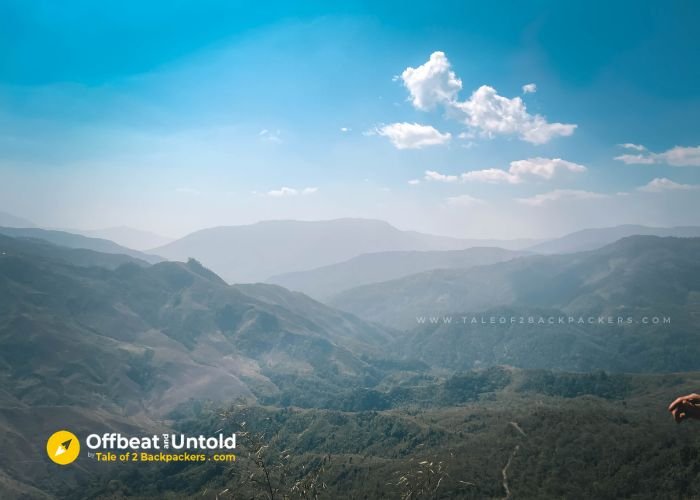
Longwa is known in the tourist circuit of India. Even though one might say Longwa is touristy, the place is still unfiltered and without the so-called tourist traps.
At Longwa, we stayed at Longwa Tourist Lodge which is located right opposite to the Ahng’s house on a hilltop.
Aoling Festival Celebrations at Longwa
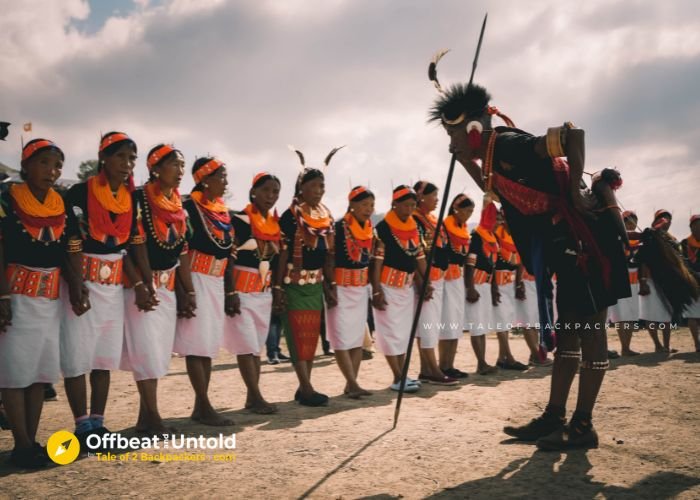
The main celebrations of the Aoling Festival at Longwa took place on the 6th day of April this year. The day was sunny and bright without a trace of rain and everyone was happy. It seemed that the Aoling spirits wanted the celebrations to go on without a hitch.
The Aoling Festival celebrations took place in the ground in front of the Longwa Baptist Church. Just like Sheanghah Chingyu, the local people in their colorful and best attires started gathering at the field. But the numbers at Longwa were more than that at Sheanghah Chingyu.
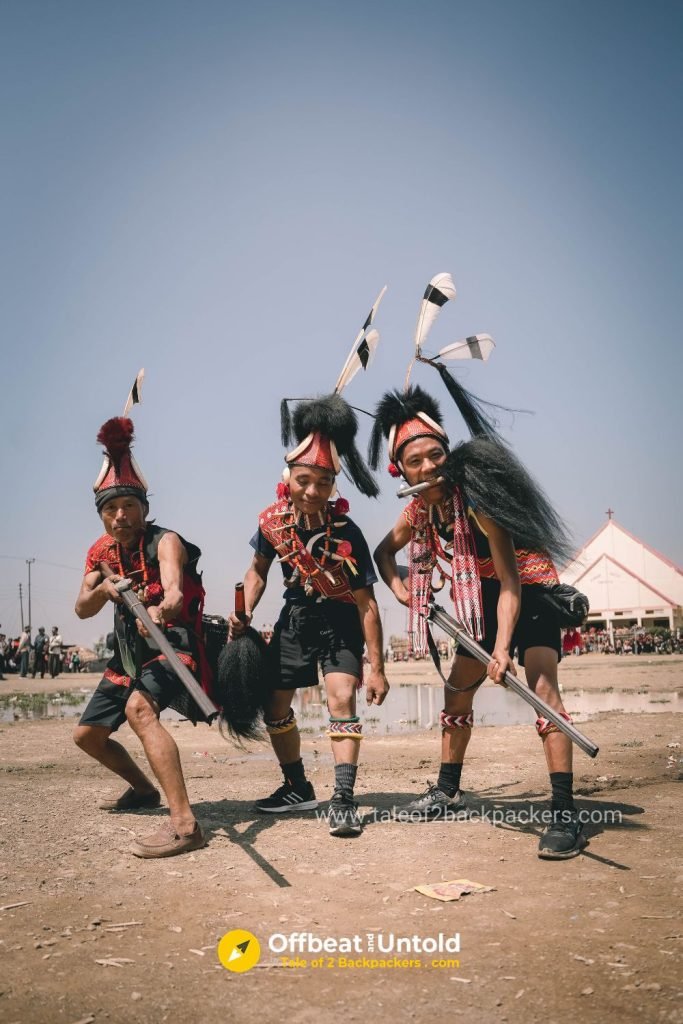
The programme started at around 11 am. Each Morung had their own group participating in the celebrations. There were groups of women performing the folk song. Then the men dressed in their traditional dresses performed the war dance. A few elder headhunters were there at the festival ground as well.
Aoling Performances
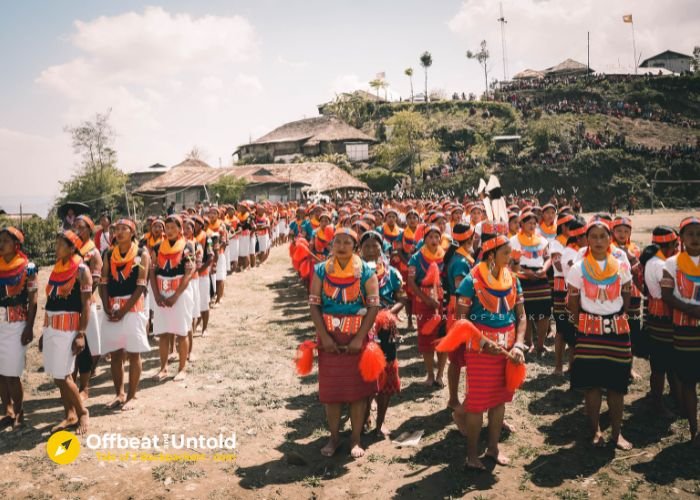
After each Morung performed their own song and dance routine, all of them started performing together. The entire field looked vibrant and cheerful. Sounds of songs and war cries permeated the surroundings. We could also hear the sounds of the log drums beating. The entire atmosphere was electric and we were also carried away by the spirit and verve of the occasion. You have to see it to believe it. In the meantime, have a look at a few of the pictures!
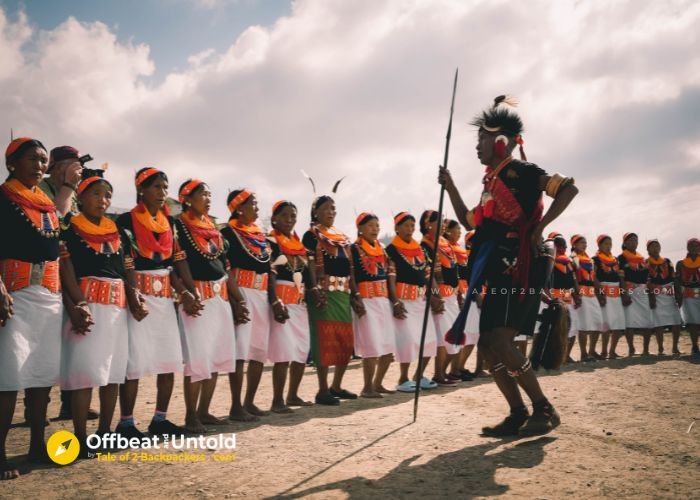


And then there was the gun firing. All the men who participated in the dance had their guns and they started shooting blank in a designated area of the field. Don’t worry, there were no real bullets there. I am sure the loud blasting of gunfire could be heard even from a distance. The entire area smelled like gunpowder. The men went around in a circle firing their guns. Even after this was over, they kept on firing guns at random.
Here too, we did not understand how time flew by. Soon we were at the end of the programme and the locals were going back to their homes. We too went back to our guest house.
In the evening, we explored Longwa and visited the gunsmith and the metal smith house. What we did in Longwa will be covered in a separate article.

Finally…
We spent a wonderful time at the villages of Mon celebrating the Aoling Festival with the Konyaks. It was an experience beyond our imagination and we will always cherish it. What separates the Aoling Festival from Hornbill is that it is totally authentic and traditional. We could see the actual rituals and traditions. And of course, it was much less touristy. Although the Aoling Festival is gradually gaining popularity, there were fewer tourists even at Longwa.
Aoling featival Travel Guide
Now for some practical information if you want to visit the Aoling Festival!
How to visit the Aoling Festival?
To experience the Aoling Festival you have to visit Mon district of Nagaland. Aoling Festival is the major festival of the Konyak tribe who lives in Mon district. The festival is celebrated in all the Konyak villages in Mon district. However, there are a few places where it is celebrated in a grander way and as a traveler or cultural enthusiast it will appeal to your senses better.
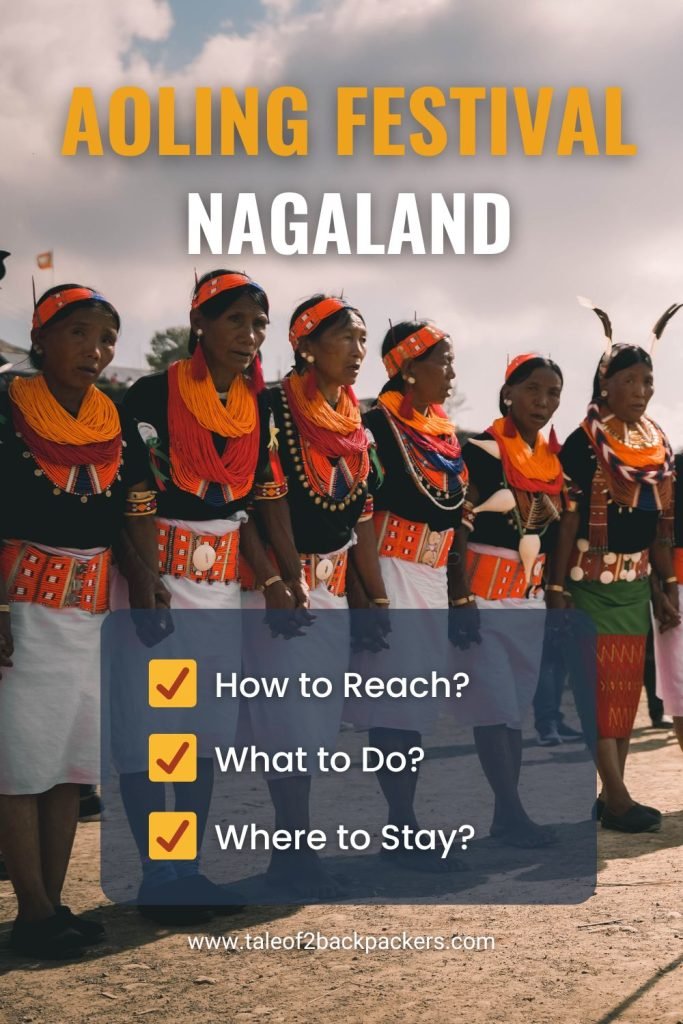
Mon Town celebrates the Aoling Festival in a grand way at the festival ground. You can also visit Mon village, Sheanghah Chungyu and Longwa to get a proper taste of the festival.
What to do at the Aoling Festival?
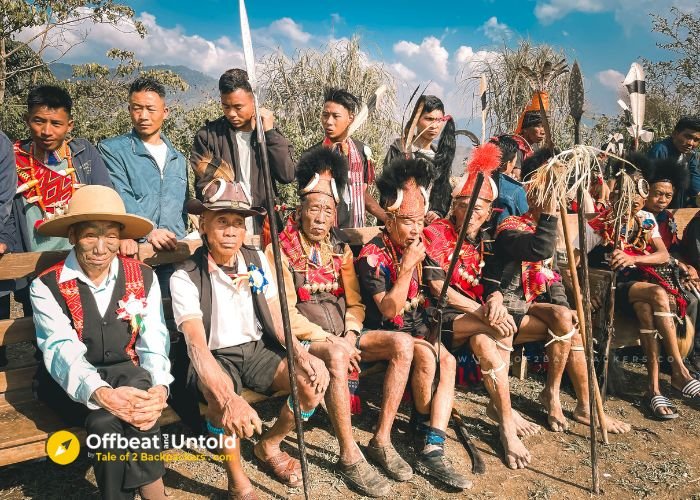
You will celebrate the festival and enjoy the programmes, of course! You can watch the song and dance performances, enactment of war dances and watch the other shows taking place,
However, if you have more time, you can do several other things.
Go for village exploration: There are several villages around Mon and you can explore them on your own. All these villages are located on hilltops and are beautiful. You can take a local guide who will give you an insight about the local culture and ways of life. He can also explain to you the several rituals taking place in the festival.
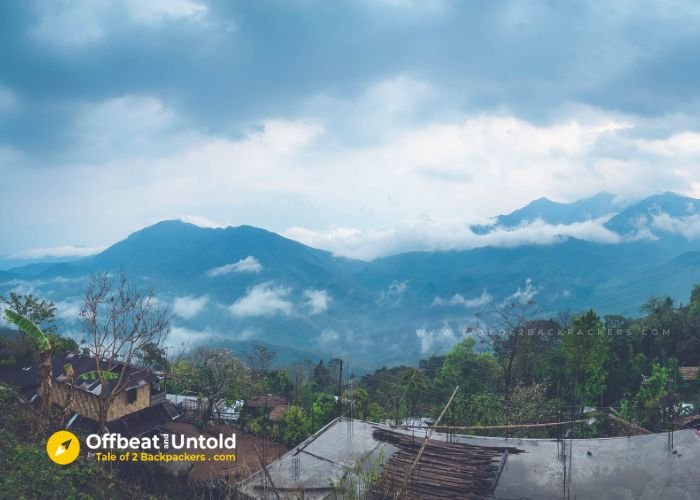
Visit the Gunsmith and Metalsmith’s house: These two places should definitely be on your list. While during the festival time, you might not see them at work, but you will be amazed to visit their houses.
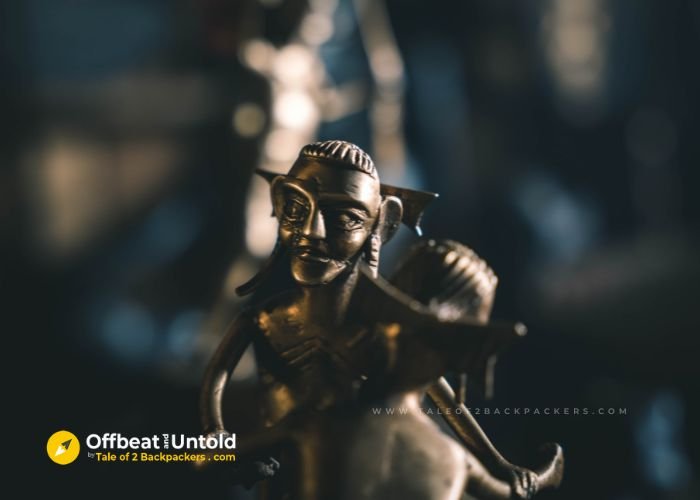
Visit the Morungs: The Morungs are like community centres or dormitories where the boys and young men stay before they get married. The Morungs are beautiful structures and you will get an insight into the life of the Konyak men once you visit there.
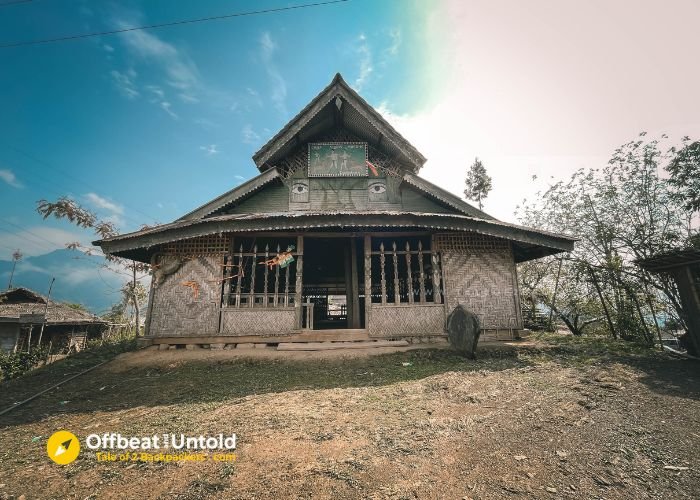
Enjoy local Naga cuisine: If you are attending the festival at Mon town, you will come across the exhibition where you will find several handlooms and handicrafts. You will also get several food stalls serving Naga cuisine and local delicacies like smoked pork, bamboo shoot curry and rice beer.
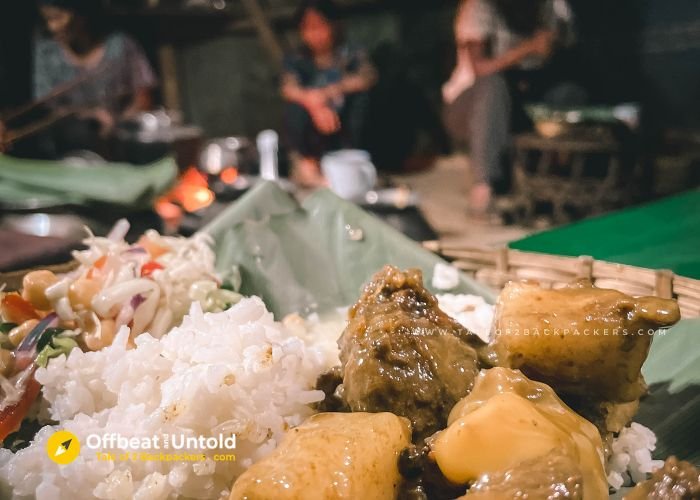
However, these food stalls are not available at the smaller villages. There you have to depend on your host.
What are he dates of Aoling Festival or Aoleang Festival?
Aoling Festival or Aoleang Monyu is celebrated every year between April 1 to 6.
How to reach Mon?
The nearest airport to Mon town is Mohanbari Airport in Dibrugarh. Mon town is located about 130 km from Dibrugarh and it takes about 5 hours to reach there. The road conditions after the border town Tizit are quite bad. You can hire a car from Dibrugarh to reach Mon.
Similarly, the nearest railway station is Dibrugarh Railway station.
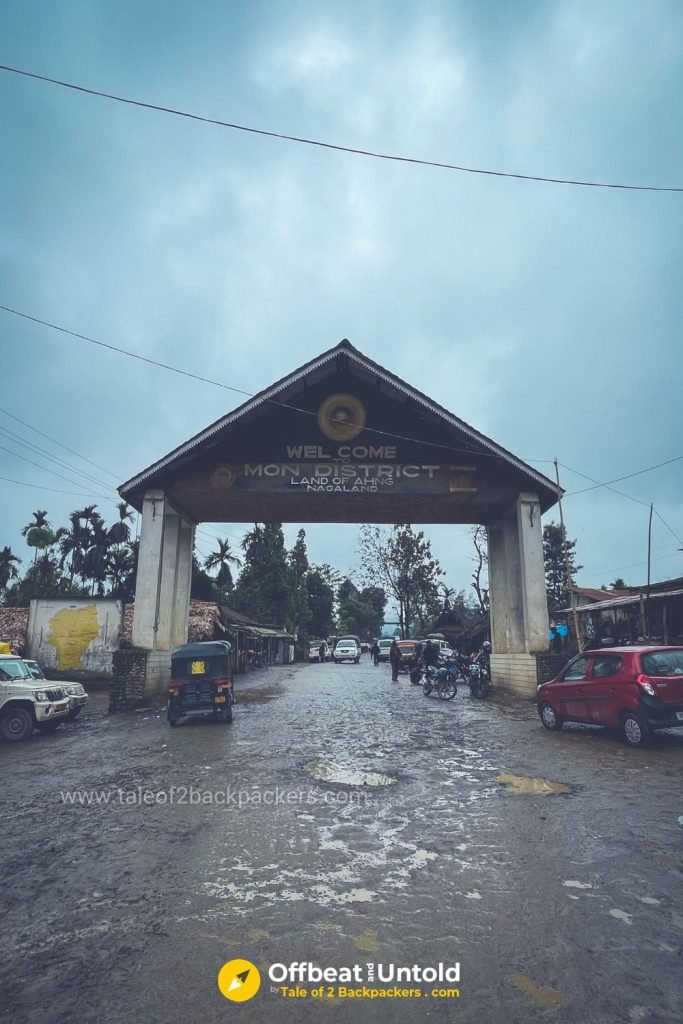
Reaching Mon by public transport
If you are looking for public transport, then you have to reach Sonari from Dibrugarh. From Sonari, you will get shared sumos towards Mon town. However, remember that these sumo to Mon from Sonari are found only in the morning by 7am. Also, during the festival season, it is difficult to get a sumo.
If you are not opposed to multiple changes of vehicles, then take an auto from Sonari to Namtola. At Namtola, cross the Assam-Nagaland border gate to go to Tizit. From Tizit, you will get shared sumos to Mon all through the day.
Dimapur/ Kohima to Mon
You can also visit Mon from Dimapur or Kohima. Dimapur has an airport. Buses are available from both Dimapur and Kohima towards Mon. The distance from Dimapur to Mon is about 280 km and it will take about 11 to 12 hours to reach Mon. Be prepared for a bumpy journey at parts.
From Kohima, buses are available as well. However, these buses actually take a longer route through Assam to reach Mon. The roads through Nagaland are quite rough and bad.
Shared sumos are also available from Kohima and Dimapur to Mon.
Once you reach Mon town, you will get shared sumos to other villages you want to visit. However, their numbers are limited and most of them run during the afternoon at around 1 pm.
Where to stay during the Aoling Festival?
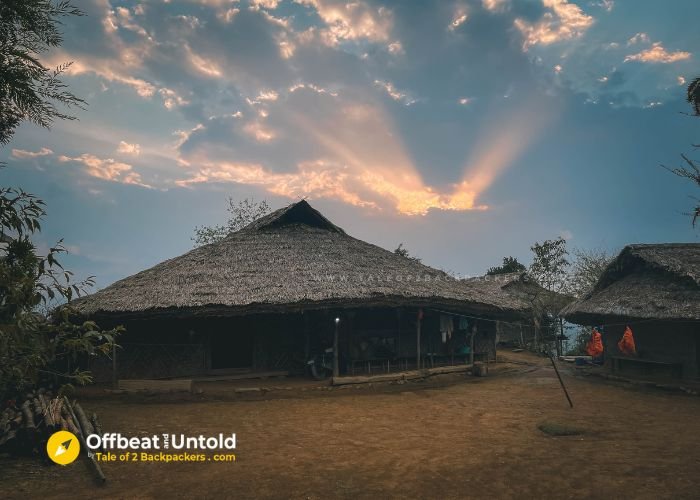
A visit to Mon or Longwa or any other village during the Aoling festival is undoubtedly going to be an unforgettable experience. However, the accommodation options at Mon are still lower in number. If you are planning to visit during the Aoling Festival, we advise you to book your stay ahead.
There are a few hotels and guest houses available at Mon town and homestays in the villages like Longwa, Mon village and Sheanghah Chingyu.
Respect the local culture and tradition
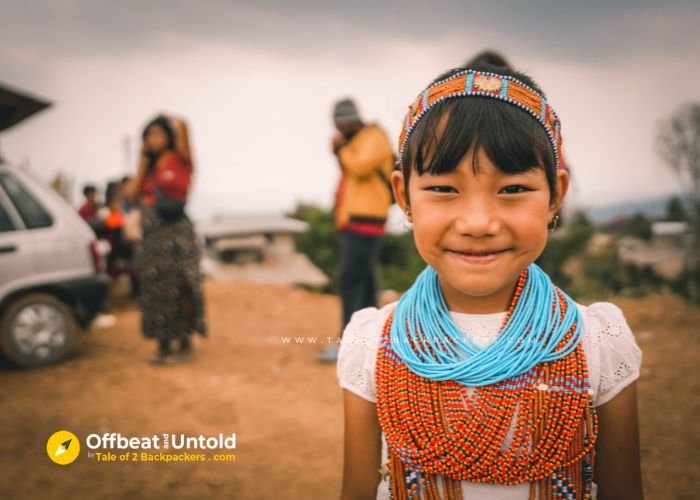
If you are traveling to Mon during the Aoling Festival or otherwise, we strongly advise you to respect the local tradition and culture of the place. Each community has their unique ways of life and we, as travelers or tourists, have the responsibility to be mindful of the impact we have on these local communities.
There might be things that you might not agree to. There might be things that you will not be comfortable about. In such cases, please keep your judgements and opinions to yourself. It is their way of life. If they do not judge you, you are in no place to do the same. If you do not like it, do not see it or hear it.
We as travelers usually come across various experiences and situations on the road. This makes us empathic and open to other cultures and views. We believe that there should be meaningful cultural exchange based on mutual understanding and trust. It is in this way we will be able to preserve the traditions of the past.
So visit Nagaland with a spirit of curiosity and celebrate the Aoling Festival with the Konyaks with the same joy.
Hope you liked this blog about the Aoling Festival? Are you planning to visit Nagaland anytime soon? Have you visited any folk festivals? Do let us know in the comments below. We would love to know about your experiences.
A Few More Photographs of Aoling Festival
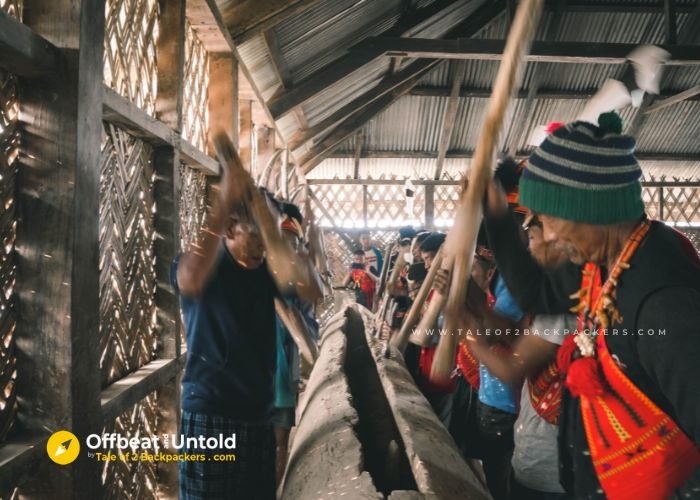














So that was Aoling Festival!





